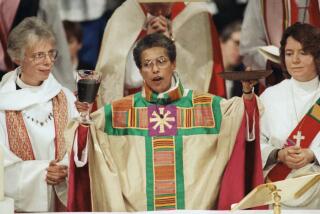Lutheran Women Wait Longer for Pastor Jobs, Survey Finds
- Share via
Seminary-trained women seeking their first jobs as pastors in the nation’s largest Lutheran denomination usually wait twice as long as men fresh from the seminary, according to a study presented to bishops of the 5.2-million-member church.
The survey of nearly 1,700 female clergy in the Evangelical Lutheran Church in America found that they waited an average of more than six months for placement, contrasted with about 3 1/2 months for their male counterparts.
Older seminary graduates--male and female--starting a second career also waited longer for an invitation from a church.
But the age factor has affected Lutheran women (who make up 13% of the church’s clergy) more than men, the survey found. The average age of women at their ordination was 35, for men 29.
“It is really a double whammy,” said the Rev. Janice Erickson-Pearson of Chicago, who co-wrote the study. She discussed it with more than 60 bishops during a recent seminar in Woodland Hills.
Although the doors opened for women’s ordination in some Lutheran churches in 1970, female clergy say that many church members still resist the notion of seeing them in the pulpit.
The Rev. Ann Tiemeyer of New York City, who chairs the denomination’s Commission for Women, said some parishioners at Christ the King Lutheran Church in Van Nuys opposed her when she began a 2 1/2-year pastorate there in late 1993.
“There are still congregations that have never heard a woman preach, even as a guest minister, or seen them do the things that pastors do,” said Tiemeyer, who left for New York when she married.
The Rev. Cynde Manion, ordained 14 years ago and pastor since 1994 of St. Luke Lutheran Church in Woodland Hills, initially encountered similar misgivings at St. Luke. Now, however, her church has an average Sunday attendance of 150 parishioners, making it one of the larger Lutheran churches in the San Fernando Valley.
“Unfortunately, the number of women [clergy] in our Los Angeles-based synod [region] has decreased in the last decade rather than increased,” Manion said.
The problem that second-career ministers have in receiving their first pastoral post was demonstrated in her congregation, Manion said.
A male church member who left his career as a construction firm executive to enter a seminary had to wait nine months for a post with a church in Northern California, she said. “What is hard is that most entry-level positions are as an assistant pastor or pastor of a very small congregation, neither of which pay very much,” Manion said.
“He is going to get a lot less money than he used to make.”
There are exceptions to the lengthy wait. The Rev. Margie Olson, pastor of the small Epiphany Lutheran Church in Canoga Park, was 65 when she graduated and was called to the church on the day she graduated. Olson, who had retired after 15 years as a public health nurse, was willing to serve “a congregation that couldn’t afford a more experienced person,” she said.
The report also contained some encouraging words.
Virtually all clergywomen in the survey have served at least some time in a congregation, due to a requirement by the Chicago-based church body that its fledgling ministers serve a local parish before taking a specialized ministry, such as teaching, chaplaincy or administrative or urban mission work.
“Other Protestant denominations in the U.S. report that a majority of their clergywomen are serving and have served in non-parish settings,” the report said.
The requirement for parish service “increases the impact of clergywomen on the whole church and provides vital preparation to significant numbers of women who may take up leadership roles.”
The study found that many female and some male clergy choose to work part time, sometimes to care for their families. But their needs may actually coincide with congregations unable to afford a full-time pastor or those churches wanting an interim pastor.
More to Read
Sign up for Essential California
The most important California stories and recommendations in your inbox every morning.
You may occasionally receive promotional content from the Los Angeles Times.









